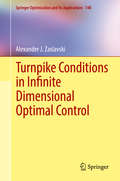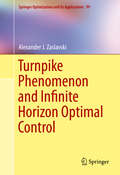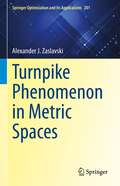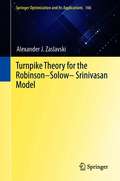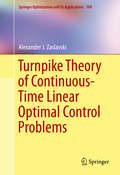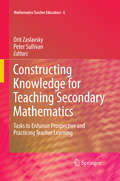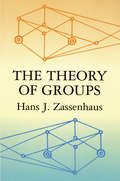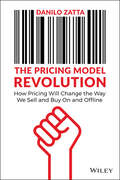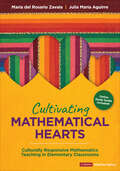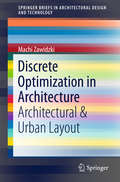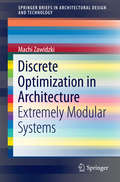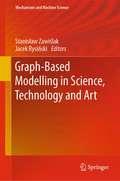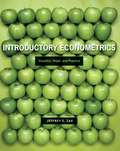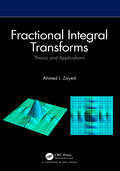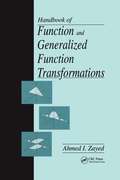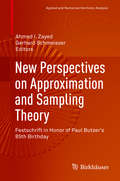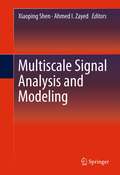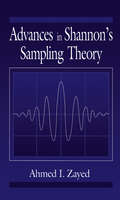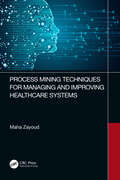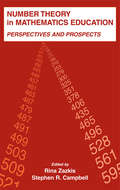- Table View
- List View
Turnpike Conditions in Infinite Dimensional Optimal Control (Springer Optimization and Its Applications #148)
by Alexander J. ZaslavskiThis book provides a comprehensive study of turnpike phenomenon arising in optimal control theory. The focus is on individual (non-generic) turnpike results which are both mathematically significant and have numerous applications in engineering and economic theory. All results obtained in the book are new. New approaches, techniques, and methods are rigorously presented and utilize research from finite-dimensional variational problems and discrete-time optimal control problems to find the necessary conditions for the turnpike phenomenon in infinite dimensional spaces. The semigroup approach is employed in the discussion as well as PDE descriptions of continuous-time dynamics. The main results on sufficient and necessary conditions for the turnpike property are completely proved and the numerous illustrative examples support the material for the broad spectrum of experts. Mathematicians interested in the calculus of variations, optimal control and in applied functional analysis will find this book a useful guide to the turnpike phenomenon in infinite dimensional spaces. Experts in economic and engineering modeling as well as graduate students will also benefit from the developed techniques and obtained results.
Turnpike Phenomenon and Infinite Horizon Optimal Control
by Alexander J. ZaslavskiThis book is devoted to the study of the turnpike phenomenon and describes the existence of solutions for a large variety of infinite horizon optimal control classes of problems. Chapter 1 provides introductory material on turnpike properties. Chapter 2 studies the turnpike phenomenon for discrete-time optimal control problems. The turnpike properties of autonomous problems with extended-value integrands are studied in Chapter 3. Chapter 4 focuses on large classes of infinite horizon optimal control problems without convexity (concavity) assumptions. In Chapter 5, the turnpike results for a class of dynamic discrete-time two-player zero-sum game are proven. This thorough exposition will be very useful for mathematicians working in the fields of optimal control, the calculus of variations, applied functional analysis and infinite horizon optimization. It may also be used as a primary text in a graduate course in optimal control or as supplementary text for a variety of courses in other disciplines. Researchers in other fields such as economics and game theory, where turnpike properties are well known, will also find this Work valuable.
Turnpike Phenomenon in Metric Spaces (Springer Optimization and Its Applications #201)
by Alexander J. ZaslavskiThis book is devoted to the study of the turnpike phenomenon arising in optimal control theory. Special focus is placed on Turnpike results, in sufficient and necessary conditions for the turnpike phenomenon and in its stability under small perturbations of objective functions. The most important feature of this book is that it develops a large, general class of optimal control problems in metric space. Additional value is in the provision of solutions to a number of difficult and interesting problems in optimal control theory in metric spaces. Mathematicians working in optimal control, optimization, and experts in applications of optimal control to economics and engineering, will find this book particularly useful.All main results obtained in the book are new. The monograph contains nine chapters. Chapter 1 is an introduction. Chapter 2 discusses Banach space valued functions, set-valued mappings in infinite dimensional spaces, and related continuous-time dynamical systems. Some convergence results are obtained. In Chapter 3, a discrete-time dynamical system with a Lyapunov function in a metric space induced by a set-valued mapping, is studied. Chapter 4 is devoted to the study of a class of continuous-time dynamical systems, an analog of the class of discrete-time dynamical systems considered in Chapter 3. Chapter 5 develops a turnpike theory for a class of general dynamical systems in a metric space with a Lyapunov function. Chapter 6 contains a study of the turnpike phenomenon for discrete-time nonautonomous problems on subintervals of half-axis in metric spaces, which are not necessarily compact. Chapter 7 contains preliminaries which are needed in order to study turnpike properties of infinite-dimensional optimal control problems. In Chapter 8, sufficient and necessary conditions for the turnpike phenomenon for continuous-time optimal control problems on subintervals of the half-axis in metric spaces, is established. In Chapter 9, the examination continues of the turnpike phenomenon for the continuous-time optimal control problems on subintervals of half-axis in metric spaces discussed in Chapter 8.
Turnpike Theory for the Robinson–Solow–Srinivasan Model (Springer Optimization and Its Applications #166)
by Alexander J. ZaslavskiThis book is devoted to the study of a class of optimal control problems arising in mathematical economics, related to the Robinson–Solow–Srinivasan (RSS) model. It will be useful for researches interested in the turnpike theory, infinite horizon optimal control and their applications, and mathematical economists. The RSS is a well-known model of economic dynamics that was introduced in the 1960s and as many other models of economic dynamics, the RSS model is determined by an objective function (a utility function) and a set-valued mapping (a technology map). The set-valued map generates a dynamical system whose trajectories are under consideration and the objective function determines an optimality criterion. The goal is to find optimal trajectories of the dynamical system, using the optimality criterion. Chapter 1 discusses turnpike properties for some classes of discrete time optimal control problems. Chapter 2 present the description of the RSS model and discuss its basic properties. Infinite horizon optimal control problems, related to the RSS model are studied in Chapter 3. Turnpike properties for the RSS model are analyzed in Chapter 4. Chapter 5 studies infinite horizon optimal control problems related to the RSS model with a nonconcave utility function. Chapter 6 focuses on infinite horizon optimal control problems with nonautonomous optimality criterions. Chapter 7 contains turnpike results for a class of discrete-time optimal control problems. Chapter 8 discusses the RSS model and compares different optimality criterions. Chapter 9 is devoted to the study of the turnpike properties for the RSS model. In Chapter 10 the one-dimensional autonomous RSS model is considered and the continuous time RSS model is studied in Chapter 11.
Turnpike Theory of Continuous-Time Linear Optimal Control Problems
by Alexander J. ZaslavskiIndividual turnpike results are of great interest due to their numerous applications in engineering and in economic theory; in this book the study is focused on new results of turnpike phenomenon in linear optimal control problems. The book is intended for engineers as well as for mathematicians interested in the calculus of variations, optimal control and in applied functional analysis. Two large classes of problems are studied in more depth. The first class studied in Chapter 2 consists of linear control problems with periodic nonsmooth convex integrands. Chapters 3-5 consist of linear control problems with autonomous convex smooth integrands. Chapter 6 discusses a turnpike property for dynamic zero-sum games with linear constraints. Chapter 7 examines genericity results. In Chapter 8, the description of structure of variational problems with extended-valued integrands is obtained. Chapter 9 ends the exposition with a study of turnpike phenomenon for dynamic games with extended value integrands.
Math Games & Activities from Around the World
by Claudia ZaslavskyMore than 70 math games, puzzles, and projects from all over the world are included in this delightful book for kids.
More Math Games & Activities from Around the World
by Claudia ZaslavskyMath, history, art, and world cultures come together in this delightful book for kids, even for those who find traditional math lessons boring. More than 70 games, puzzles, and projects encourage kids to hone their math skills as they calculate, measure, and solve problems. The games span the globe, and many have been played for thousands of years, such as three-in-a-row games like Achi from Ghana or the forbidden game of Jirig from Mongolia. Also included are imaginative board games like Lambs and Tigers from India and the Little Goat Game from Sudan, or bead and string puzzles from China, and M+bius strip puzzles from Germany. Through compelling math play, children will gain confidence and have fun as they learn about the different ways people around the world measure, count, and use patterns and symmetry in their everyday lives.
Number Sense and Nonsense: Building Math Creativity and Confidence Through Number Play
by Claudia ZaslavskyThese 80-plus math activities and number games help kids to think critically about math instead of just memorizing rules. The emphasis is on the underlying relationships between numbers and the process of manipulating them. Kids get together and play games with odd and even numbers, prime and composite numbers, factors, divisors, and multiples of numbers, common and decimal fractions. Children learn the history of numbers--finger counting, number symbols in various cultures, and different ways of calculating. The book is full of riddles, puzzles, number tricks, and calculator games. Kids develop skills in estimation and computation as they become familiar with the characteristics and behavior of numbers. They will gain math confidence and be ready to take chances, find their own errors, and challenge their peers.
Constructing Knowledge for Teaching Secondary Mathematics: Tasks to enhance prospective and practicing teacher learning (Mathematics Teacher Education #6)
by Orit Zaslavsky Peter SullivanTeacher education seeks to transform prospective and/or practicing teachers from neophyte possibly uncritical perspectives on teaching and learning to more knowledgeable, adaptable, analytic, insightful, observant, resourceful, reflective and confident professionals ready to address whatever challenges teaching secondary mathematics presents. This transformation occurs optimally through constructive engagement in tasks that foster knowledge for teaching secondary mathematics. Ideally such tasks provide a bridge between theory and practice, and challenge, surprise, disturb, confront, extend, or provoke examination of alternatives, drawn from the context of teaching. We define tasks as the problems or activities that, having been developed, evaluated and refined over time, are posed to teacher education participants. Such participants are expected to engage in these tasks collaboratively, energetically, and intellectually with an open mind and an orientation to future practice. The tasks might be similar to those used by classroom teachers (e.g., the analysis of a graphing problem) or idiosyncratic to teacher education (e.g., critique of videotaped practice). This edited volume includes chapters based around unifying themes of tasks used in secondary mathematics teacher education. These themes reflect goals for mathematics teacher education, and are closely related to various aspects of knowledge required for teaching secondary mathematics. They are not based on the conventional content topics of teacher education (e.g., decimals, grouping practices), but on broad goals such as adaptability, identifying similarities, productive disposition, overcoming barriers, micro simulations, choosing tools, and study of practice. This approach is innovative and appeals both to prominent authors and to our target audiences.
Quantitative Reasoning: Thinking in Numbers
by Eric ZaslowIs college worth the cost? Should I worry about arsenic in my rice? Can we recycle pollution? Real questions of personal finance, public health, and social policy require sober, data-driven analyses. This unique text provides students with the tools of quantitative reasoning to answer such questions. The text models how to clarify the question, recognize and avoid bias, isolate relevant factors, gather data, and construct numerical analyzes for interpretation. Themes and techniques are repeated across chapters, with a progression in mathematical sophistication over the course of the book, which helps the student get comfortable with the process of thinking in numbers. This textbook includes references to source materials and suggested further reading, making it user-friendly for motivated undergraduate students. The many detailed problems and worked solutions in the text and extensive appendices help the reader learn mathematical areas such as algebra, functions, graphs, and probability. End-of-chapter problem material provides practice for students, and suggested projects are provided with each chapter. A solutions manual is available online for instructors.
The Theory of Groups (Dover Books on Mathematics)
by Hans J. ZassenhausGroup theory represents one of the most fundamental elements of mathematics. Indispensable in nearly every branch of the field, concepts from the theory of groups also have important applications beyond mathematics, in such areas as quantum mechanics and crystallography.Hans J. Zassenhaus, a pioneer in the study of group theory, has designed this useful, well-written, graduate-level text to acquaint the reader with group-theoretic methods and to demonstrate their usefulness as tools in the solution of mathematical and physical problems. Starting with an exposition of the fundamental concepts of group theory, including an investigation of axioms, the calculus of complexes, and a theorem of Frobenius, the author moves on to a detailed investigation of the concept of homomorphic mapping, along with an examination of the structure and construction of composite groups from simple components. The elements of the theory of p-groups receive a coherent treatment, and the volume concludes with an explanation of a method by which solvable factor groups may be split off from a finite group.Many of the proofs in the text are shorter and more transparent than the usual, older ones, and a series of helpful appendixes presents material new to this edition. This material includes an account of the connections between lattice theory and group theory, and many advanced exercises illustrating both lattice-theoretical ideas and the extension of group-theoretical concepts to multiplicative domains.
The Pricing Model Revolution: How Pricing Will Change the Way We Sell and Buy On and Offline
by Danilo ZattaAn incisive and accessible blueprint to pricing your company’s products and services In The Pricing Model Revolution: How Pricing Will Change the Way We Sell and Buy On and Offline, world renowned pricing expert Danilo Zatta delivers an essential and engaging blueprint to building an enduring competitive advantage with insightful pricing models. In the book, you’ll learn to identify the best monetization approaches for your products and how to execute the one that makes the most sense for your business. From freemium to subscription, pay-per-use, and even neuropricing, the author discusses every available option and shows you how to choose. Although it's rigorous and evidence backed, The Pricing Model Revolution avoids an overly academic perspective in favour of providing you with concrete, practical guidance you can apply immediately to start generating more revenue. You’ll learn things like: How to make smart and innovative pricing a core component of your next product offering How to distinguish between every new, future-oriented monetization approach Which factors to consider when you’re choosing on a new pricing model for your most popular products An essential read for C-level executives, managers, entrepreneurs, and sales team leaders, The Pricing Model Revolution belongs on the bookshelves of every business leader seeking to learn more about one of the foundational topics driving top-line revenue and bottom-line profitability today.
Cultivating Mathematical Hearts: Culturally Responsive Mathematics Teaching in Elementary Classrooms (Corwin Mathematics Series)
by Maria del Zavala Julia Maria AguirreHelp students see their whole selves in the math they′re learning with culturally responsive teaching. Cultivating Mathematical Hearts: Culturally Responsive Mathematics Teaching in Elementary Classrooms, aims to re-center mathematics as a humanizing endeavor because putting children and their humanity at the heart of mathematics education can result in more engaged, meaningful, and joyful learning. This book introduces a model and a tool for Culturally Responsive Mathematics Teaching, constructed to create a safe, inclusive space where all learners can come together in their own educational journey and develop a love for math that centers their experiences and comes from the heart. Implementing the Culturally Responsive Mathematics Teaching Tool (CRMT2) will help you cultivate and sustain meaningful, rich, and rigorous mathematical learning spaces for all your students–experiences that foster mathematical curiosity and joy. The book walks you through each aspect of the framework and tool, guiding you to consider how your classroom structures, lessons, tasks, and assessments: Honor the existing cultural strengths, experiences, and lived realities of all your students Elicit diverse mathematical thinking and ideas Support equitable access to rigorous mathematical learning and discourse for all students Invite a sense of agency in each student’s learning experience Promote high engagement and excitement while learning mathematics Nurture an understanding that mathematics is a powerful tool for making sense of the world By weaving these strategies into classroom lessons, teachers can humanize mathematics instruction to successfully build a love for math while providing equitable learning opportunities that empower student voice and promote success in mathematics.
Cultivating Mathematical Hearts: Culturally Responsive Mathematics Teaching in Elementary Classrooms (Corwin Mathematics Series)
by Maria del Zavala Julia Maria AguirreHelp students see their whole selves in the math they′re learning with culturally responsive teaching. Cultivating Mathematical Hearts: Culturally Responsive Mathematics Teaching in Elementary Classrooms, aims to re-center mathematics as a humanizing endeavor because putting children and their humanity at the heart of mathematics education can result in more engaged, meaningful, and joyful learning. This book introduces a model and a tool for Culturally Responsive Mathematics Teaching, constructed to create a safe, inclusive space where all learners can come together in their own educational journey and develop a love for math that centers their experiences and comes from the heart. Implementing the Culturally Responsive Mathematics Teaching Tool (CRMT2) will help you cultivate and sustain meaningful, rich, and rigorous mathematical learning spaces for all your students–experiences that foster mathematical curiosity and joy. The book walks you through each aspect of the framework and tool, guiding you to consider how your classroom structures, lessons, tasks, and assessments: Honor the existing cultural strengths, experiences, and lived realities of all your students Elicit diverse mathematical thinking and ideas Support equitable access to rigorous mathematical learning and discourse for all students Invite a sense of agency in each student’s learning experience Promote high engagement and excitement while learning mathematics Nurture an understanding that mathematics is a powerful tool for making sense of the world By weaving these strategies into classroom lessons, teachers can humanize mathematics instruction to successfully build a love for math while providing equitable learning opportunities that empower student voice and promote success in mathematics.
Discrete Optimization in Architecture
by Machi ZawidzkiThis book is comprised of two parts, both of which exploremodular systems: Pipe-Z (PZ) and Truss-Z (TZ), respectively. It presents severalmethods of creating PZ and TZ structures subjected to discrete optimization. The algorithms presented employ graph-theoretic and heuristic methods. Theunderlying idea of both systems is to create free-form structures using theminimal number of types of modular elements. PZ is more conceptual, as it formssingle-branch mathematical knots with a single type of module. Conversely, TZis a skeletal system for creating free-form pedestrian ramps and ramp networksamong any number of terminals in space. In physical space, TZ uses two types ofmodules that are mirror reflections of each other. The optimization criteriadiscussed include: the minimal number of units, maximal adherence to the givenguide paths, etc.
Discrete Optimization in Architecture
by Machi ZawidzkiThis book is comprised of two parts, both of which exploremodular systems: Pipe-Z (PZ) and Truss-Z (TZ), respectively. It presents severalmethods of creating PZ and TZ structures subjected to discrete optimization. The algorithms presented employ graph-theoretic and heuristic methods. Theunderlying idea of both systems is to create free-form structures using theminimal number of types of modular elements. PZ is more conceptual, as it formssingle-branch mathematical knots with a single type of module. Conversely, TZis a skeletal system for creating free-form pedestrian ramps and ramp networksamong any number of terminals in space. In physical space, TZ uses two types ofmodules that are mirror reflections of each other. The optimization criteriadiscussed include: the minimal number of units, maximal adherence to the givenguide paths, etc.
Graph-Based Modelling in Science, Technology and Art (Mechanisms and Machine Science #107)
by Stanisław Zawiślak Jacek RysińskiThis book presents interdisciplinary, cutting-edge and creative applications of graph theory and modeling in science, technology, architecture and art. Topics are divided into three parts: the first one examines mechanical problems related to gears, planetary gears and engineering installations; the second one explores graph-based methods applied to medical analyses as well as biological and chemical modeling; and the third part includes various topics e.g. drama analysis, aiding of design activities and network visualisation. The authors represent several countries in Europe and America, and their contributions show how different, useful and fruitful the utilization of graphs in modelling of engineering systems can be. The book has been designed to serve readers interested in the subject of graph modelling and those with expertise in related areas, as well as members of the worldwide community of graph modelers.
Introductory Econometrics: Intuition, Proof, and Practice
by Jeffrey S. ZaxIntroductory Econometrics: Intuition, Proof, and Practice attempts to distill econometrics into a form that preserves its essence, but that is acceptable--and even appealing--to the student's intellectual palate. This book insists on rigor when it is essential, but it emphasizes intuition and seizes upon entertainment wherever possible. Introductory Econometrics is motivated by three beliefs. First, students are, perhaps despite themselves, interested in questions that only econometrics can answer. Second, through these answers, they can come to understand, appreciate, and even enjoy the enterprise of econometrics. Third, this text, which presents select innovations in presentation and practice, can provoke readers' interest and encourage the responsible and insightful application of econometric techniques. In particular, author Jeffrey S. Zax gives readers many opportunities to practice proofs--which are challenging, but which he has found to improve student comprehension. Learning from proofs gives readers an organic understanding of the message behind the numbers, a message that will benefit them as they come across statistics in their daily lives. An ideal core text for foundational econometrics courses, this book is appropriate for any student with a solid understanding of basic algebra--and a willingness to use that tool to investigate complicated issues.
Fractional Integral Transforms: Theory and Applications
by Ahmed I. ZayedFractional Integral Transforms: Theory and Applications presents over twenty-five integral transforms, many of which have never before been collected in one single volume. Some transforms are classic, such as Laplace, Fourier, etc, and some are relatively new, such as the Fractional Fourier, Gyrator, Linear Canonical, Special Affine Fourier Transforms, as well as, continuous Wavelet, Ridgelet, and Shearlet transforms.The book provides an overview of the theory of fractional integral transforms with examples of such transforms, before delving deeper into the study of important fractional transforms, including the fractional Fourier transform. Applications of fractional integral transforms in signal processing and optics are highlighted. The book’s format has been designed to make it easy for readers to extract the essential information they need to learn the about the fundamental properties of each transform. Supporting proofs and explanations are given throughout.Features Brings together integral transforms never before collected into a single volume A useful resource on fractional integral transforms for researchers and graduate students in mathematical analysis, applied mathematics, physics and engineering Written in an accessible style with detailed proofs and emphasis on providing the reader with an easy access to the essential properties of important fractional integral transforms Ahmed I. Zayed is a Professor of Mathematics at the Department of Mathematical Sciences, DePaul University, Chicago, and was the Chair of the department for 20 years, from 2001 until 2021. His research interests varied over the years starting with generalized functions and distributions to sampling theory, applied harmonic analysis, special functions and integral transforms. He has published two books and edited seven research monographs. He has written 22 book chapters, published 118 research articles, and reviewed 173 publications for the Mathematical Review and 81 for the Zentralblatt für Mathematik (zbMath). He has served on the Editorial Boards of 22 scientific research journals and has refereed over 200 research papers submitted to prestigious journals, among them are IEEE, SIAM, Amer. Math. Soc., Math Physics, and Optical Soc. Journals.
Handbook of Function and Generalized Function Transformations
by Ahmed I. ZayedFunction transformations, which include linear integral transformations, are some of the most important mathematical tools for solving problems in all areas of engineering and the physical sciences. They allow one to quickly solve a problem by breaking it down into a series of smaller, more manageable problems.The author has compiled the most important and widely used of these function transforms in applied mathematics and electrical engineering. In addition to classical transforms, newer transforms such as wavelets, Zak, and Radon are included. The book is neither a table of transforms nor a textbook, but it is a source book that provides quick and easy access to the most important properties and formulas of function and generalized function transformations. It is organized for convenient reference, with chapters broken down into the following sections:
New Perspectives on Approximation and Sampling Theory
by Ahmed I. Zayed Gerhard SchmeisserPaul Butzer, who is considered the academic father and grandfather of many prominent mathematicians, has established one of the best schools in approximation and sampling theory in the world. He is one of the leading figures in approximation, sampling theory, and harmonic analysis. Although on April 15, 2013, Paul Butzer turned 85 years old, remarkably, he is still an active research mathematician. In celebration of Paul Butzer's 85th birthday, New Perspectives on Approximation and Sampling Theory is a collection of invited chapters on approximation, sampling, and harmonic analysis written by students, friends, colleagues, and prominent active mathematicians. Topics covered include approximation methods using wavelets, multi-scale analysis, frames, and special functions. New Perspectives on Approximation and Sampling Theory requires basic knowledge of mathematical analysis, but efforts were made to keep the exposition clear and the chapters self-contained. This volume will appeal to researchers and graduate students in mathematics, applied mathematics and engineering, in particular, engineers working in signal and image processing.
Multiscale Signal Analysis and Modeling
by Ahmed I. Zayed Xiaoping ShenMultiscale Signal Analysis and Modeling presents recent advances in multiscale analysis and modeling using wavelets and other systems. This book also presents applications in digital signal processing using sampling theory and techniques from various function spaces, filter design, feature extraction and classification, signal and image representation/transmission, coding, nonparametric statistical signal processing, and statistical learning theory.
Advances in Shannon's Sampling Theory
by AhmedI. ZayedAdvances in Shannon's Sampling Theory provides an up-to-date discussion of sampling theory, emphasizing the interaction between sampling theory and other branches of mathematical analysis, including the theory of boundary-value problems, frames, wavelets, multiresolution analysis, special functions, and functional analysis. The author not only traces the history and development of the theory, but also presents original research and results that have never before appeared in book form. Recent techniques covered include the Feichtinger-Gröchenig sampling theory; frames, wavelets, multiresolution analysis and sampling; boundary-value problems and sampling theorems; and special functions and sampling theorems. The book will interest graduate students and professionals in electrical engineering, communications, and applied mathematics.
Process Mining Techniques for Managing and Improving Healthcare Systems
by Maha ZayoudThis book discusses a new process mining method along with a detailed comparison between different techniques that provide a complete vision of the process of data acquisition, data analysis, and data prediction. Process Mining Techniques for Managing and Improving Healthcare Systems offers a new framework for process learning which is probabilistic and enables the process to be learned in an accumulative manner. The steps of prediction modeling and building the required knowledge are highlighted throughout the book, along with a strong emphasis on the correlation between the healthcare domain and technology including the different aspects, such as: managing records, information, and procedures; early detection of diseases; and the improvement of accuracy in choosing the right treatment procedures. This reference provides a wealth of knowledge for practitioners, researchers, and students at the basic and intermediary levels working within the healthcare system, computer science, electronics and communications, as well as medical providers and also hospital management entities.
Number Theory in Mathematics Education: Perspectives and Prospects (Studies in Mathematical Thinking and Learning Series)
by Rina Zazkis Stephen R. CampbellThis book offers multiple interconnected perspectives on the largely untapped potential of elementary number theory for mathematics education: its formal and cognitive nature, its relation to arithmetic and algebra, its accessibility, its utility and intrinsic merits, to name just a few. Its purpose is to promote explication and critical dialogue about these issues within the international mathematics education community. The studies comprise a variety of pedagogical and research orientations by an international group of researchers that, collectively, make a compelling case for the relevance and importance of number theory in mathematics education in both pre K-16 settings and mathematics teacher education.Topics variously engaged include:*understanding particular concepts related to numerical structure and number theory;*elaborating on the historical and psychological relevance of number theory in concept development;*attaining a smooth transition and extension from pattern recognition to formative principles;*appreciating the aesthetics of number structure;*exploring its suitability in terms of making connections leading to aha! insights and reaching toward the learner's affective domain;*reexamining previously constructed knowledge from a novel angle;*investigating connections between technique and theory;*utilizing computers and calculators as pedagogical tools; and*generally illuminating the role number theory concepts could play in developing mathematical knowledge and reasoning in students and teachers.Overall, the chapters of this book highlight number theory-related topics as a stepping-stone from arithmetic toward generalization and algebraic formalism, and as a means for providing intuitively grounded meanings of numbers, variables, functions, and proofs.Number Theory in Mathematics Education: Perspectives and Prospects is of interest to researchers, teacher educators, and students in the field of mathematics education, and is well suited as a text for upper-level mathematics education courses.
